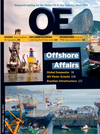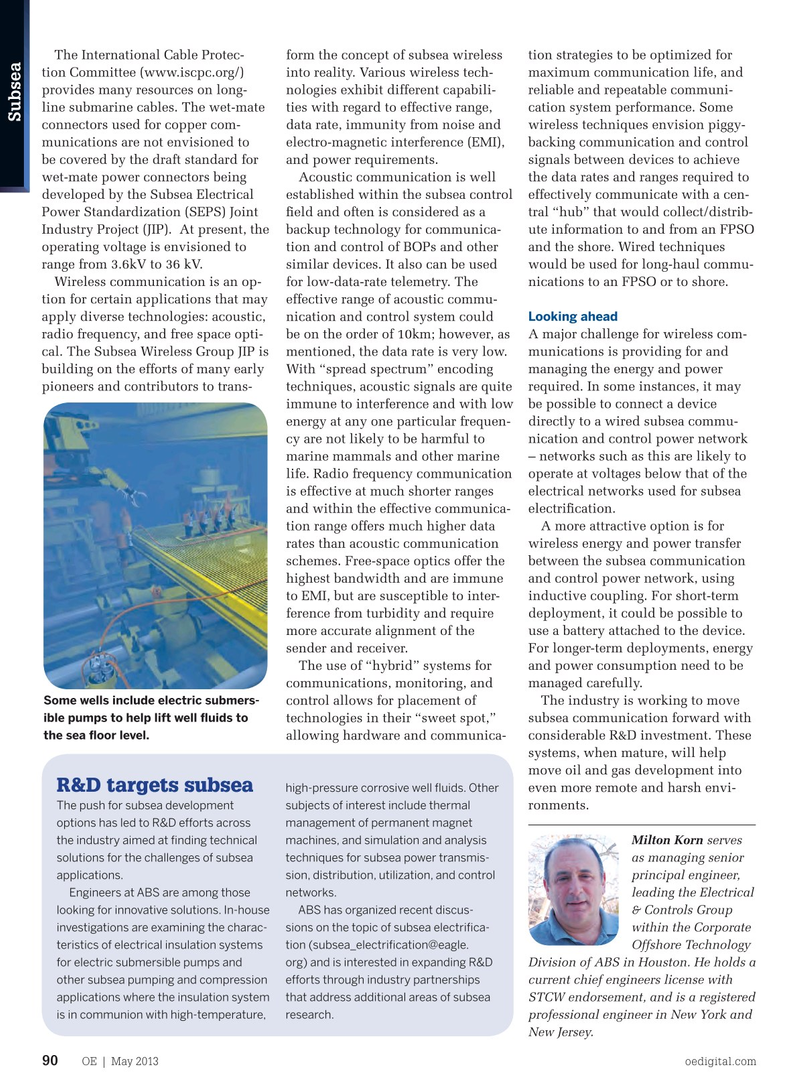
Page 88: of Offshore Engineer Magazine (May/Jun 2013)
Read this page in Pdf, Flash or Html5 edition of May/Jun 2013 Offshore Engineer Magazine
The International Cable Protec- form the concept of subsea wireless tion strategies to be optimized for tion Committee (www.iscpc.org/) into reality. Various wireless tech- maximum communication life, and provides many resources on long- nologies exhibit different capabili- reliable and repeatable communi- line submarine cables. The wet-mate ties with regard to effective range, cation system performance. Some
Subsea connectors used for copper com- data rate, immunity from noise and wireless techniques envision piggy- munications are not envisioned to electro-magnetic interference (EMI), backing communication and control be covered by the draft standard for and power requirements. signals between devices to achieve wet-mate power connectors being Acoustic communication is well the data rates and ranges required to developed by the Subsea Electrical established within the subsea control effectively communicate with a cen-
Power Standardization (SEPS) Joint feld and often is considered as a tral “hub” that would collect/distrib-
Industry Project (JIP). At present, the backup technology for communica- ute information to and from an FPSO operating voltage is envisioned to tion and control of BOPs and other and the shore. Wired techniques range from 3.6kV to 36 kV. similar devices. It also can be used would be used for long-haul commu-
Wireless communication is an op- for low-data-rate telemetry. The nications to an FPSO or to shore. tion for certain applications that may effective range of acoustic commu-
Looking ahead apply diverse technologies: acoustic, nication and control system could radio frequency, and free space opti- be on the order of 10km; however, as A major challenge for wireless com- cal. The Subsea Wireless Group JIP is mentioned, the data rate is very low. munications is providing for and building on the efforts of many early With “spread spectrum” encoding managing the energy and power pioneers and contributors to trans- techniques, acoustic signals are quite required. In some instances, it may immune to interference and with low be possible to connect a device energy at any one particular frequen- directly to a wired subsea commu- cy are not likely to be harmful to nication and control power network marine mammals and other marine – networks such as this are likely to life. Radio frequency communication operate at voltages below that of the is effective at much shorter ranges electrical networks used for subsea and within the effective communica- electrifcation. tion range offers much higher data A more attractive option is for rates than acoustic communication wireless energy and power transfer schemes. Free-space optics offer the between the subsea communication highest bandwidth and are immune and control power network, using to EMI, but are susceptible to inter- inductive coupling. For short-term ference from turbidity and require deployment, it could be possible to more accurate alignment of the use a battery attached to the device. sender and receiver. For longer-term deployments, energy
The use of “hybrid” systems for and power consumption need to be communications, monitoring, and managed carefully.
Some wells include electric submers- control allows for placement of The industry is working to move ible pumps to help lift well fuids to technologies in their “sweet spot,” subsea communication forward with the sea foor level.
allowing hardware and communica- considerable R&D investment. These systems, when mature, will help move oil and gas development into
R&D targets subsea high-pressure corrosive well fuids. Other even more remote and harsh envi-
The push for subsea development subjects of interest include thermal ronments.
options has led to R&D efforts across management of permanent magnet the industry aimed at fnding technical machines, and simulation and analysis
Milton Korn serves solutions for the challenges of subsea techniques for subsea power transmis- as managing senior applications. sion, distribution, utilization, and control principal engineer,
Engineers at ABS are among those networks. leading the Electrical looking for innovative solutions. In-house ABS has organized recent discus- & Controls Group investigations are examining the charac- sions on the topic of subsea electrifca- within the Corporate teristics of electrical insulation systems tion (subsea_electrifcation@eagle.
Offshore Technology for electric submersible pumps and org) and is interested in expanding R&D
Division of ABS in Houston. He holds a other subsea pumping and compression efforts through industry partnerships current chief engineers license with applications where the insulation system that address additional areas of subsea
STCW endorsement, and is a registered is in communion with high-temperature, research.
professional engineer in New York and
New Jersey.
OE | May 2013 oedigital.com 90 subsea1_abs.indd 90 4/22/13 5:57 PM

 87
87

 89
89